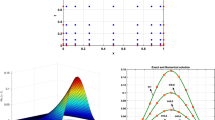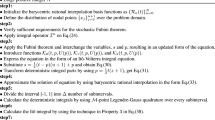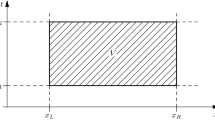Abstract
A fast finite difference method based on the monotone iterative method and the fast Poisson solver on irregular domains for a 2D nonlinear Poisson–Boltzmann equation is proposed and analyzed in this paper. Each iteration of the monotone method involves the solution of a linear equation in an exterior domain with an arbitrary interior boundary. A fast immersed interface method for generalized Helmholtz equations on exterior irregular domains is used to solve the linear equation. The monotone iterative method leads to a sequence which converges monotonically from either above or below to a unique solution of the problem. This monotone convergence guarantees the existence and uniqueness of a solution as well as the convergence of the finite difference solution to the continuous solution. A comparison of the numerical results against the exact solution in an example indicates that our method is second order accurate. We also compare our results with available data in the literature to validate the numerical method. Our method is efficient in terms of accuracy, speed, and flexibility in dealing with the geometry of the domain
Similar content being viewed by others
References
Adams, J., Swarztrauber, P., and Sweet, R. Fishpack: Efficient Fortran subprograms for the solution of separable elliptic partial differential equations. http://www.netlib.org/fishpack/.
Baker N., Holst M., and Wang F. (2000). Adaptive multilevel finite element solution of the Poisson–Boltzmann equation; II: Refinement at solvent accessible surfaces in biomolecular systems. J. Comput. Chem. 21:1343–1352
Baker N., Sept D., Holst M., and McCammon J.A. (2001). The adaptive multilevel finite element solution of the Poisson–Boltzmann equation on massively parallel computers. IBM J. Res. Dev. 45(3/4):427
Bowen W.R., and Sharif A.O. (1998). Long-range electrostatic attraction between like-charge spheres in a charged pore. Nature 393:663–665
Bowen W.R., and Williams P.M. (2002). Finite difference solution of the 2-dimensional Poisson–Boltzmann equation for spheres in confined geometries. Colloids–Surfaces A: Physicochem. and Eng. Aspects 204:103–115
Carnie S.L., Chan D.Y.C., and Stankovich J. (1994). Computation of forces between spherical colloidal particles: nonlinear Poisson–Boltzmann theory. J. Colloid Interface Sci. 165:116–128
Chern I.-L., Liu J.-C., and Wang W.-C. (2003). Accurate evaluation of electrostatics for macromolecules in solution. Methods Appl. Anal. 10:309–328
Dyshlovenko P. (2001). Adaptive mesh enrichment for the Poisson–Boltzmann equation. J. Comp. Phys. 172:198–208
Dyshlovenko P. (2002). Adaptive numerical method for Poisson–Boltzmann equation and its application. Comp. Phys. Communi. 147:335–338
Harries D. (1998). Solving the Poisson–Boltzmann equation for two parallel cylinders. Langmuir 14:3149–3152
Holst, M. (1993). Multilevel methods for the Poisson–Boltzmann equation. Ph.D thesis Numerical Computing Group, University of Illinois at Urbana-Champaign
Holst M., Baker N., and Wang F. (2000). Adaptive multilevel finite element solution of the Poisson–Boltzmann equation; I: Algorithms and examples. J. Comput. Chem. 21:1319–1342
Hoskin N.E. (1956). The interaction of two identical spherical colloidal particles I. Potential Distribution. Proc. Royal Soc. (London), Ser. A 248:433–448
Hou T., Li Z., Osher S., and Zhao H. (1997). A hybrid method for moving interface problems with application to the Hele-Shaw flow. J. Comput. Phys. 134:236–252
LeVeque R.J., and Li Z. (1994). The immersed interface method for elliptic equations with discontinuous coefficients and singular sources. SIAM J. Numer. Anal. 31:1019–1044
Li, Z. (1994). The Immersed Interface Method—A Numerical Approach for Partial Differential Equations with Interfaces. PhD thesis, University of Washington
Li Z. (1998). A fast iterative algorithm for elliptic interface problems. SIAM J. Numer. Anal. 35:230–254
Li Z., Zhao H., and Gao H. (1999). A numerical study of electro-migration voiding by evolving level set functions on a fixed cartesian grid. J. Comput. Phys. 152:281–304
Nicholls A., and Honig B. (1991). A rapid finite difference algorithm, utilizing successive over-relaxation to solve the Poisson–Boltzmann equation. J. Comp. Chem. 12:435
Osher S., and Fedkiw R. (2002). Level Set Methods and Dynamic Implicit Surfaces. Springer, New York
Ospeck M., and Fraden S. (1998). Solving the Poisson–Boltzmann equation to obtain interaction energies between confined, like-charged cylinders. J. Chem. Phys. 109(20):9166–9171
Pao C.V. (1985). Monotone iterative methods for finite difference system of reaction diffusion equations. Numer. Math. 46:571–586
Pao, C.V. (1989). Asymptotic behavior of solutions for finite difference equations of reaction diffusion. J. Math. Anal. Appl. 144:206–225
Pao C.V. (1992). Nonlinear Parabolic and Elliptic Equations. Plenum Press, New York
Pao C.V. (1995). Block monotone iterative methods for numerical solutions of nonlinear elliptic equations. Numer. Math. 72:239–262
Pao C.V. and Lu X. (2003). Block monotone iterations for numerical solutions of fourth-order nonlinear elliptic boundary value problems. SIAM J. Sci. Comput. 25:164–185
Sethian, J.A. (1999). Level Set Methods and Fast Marching Methods, 2nd edn, Cambridge University Press
Tsynkov S. (1998). Numerical solution of problems on unbounded domains. a review. Appl. Numer. Math. 27:465–532
Author information
Authors and Affiliations
Corresponding author
Rights and permissions
About this article
Cite this article
Li, Z., Pao, C.V. & Qiao, Z. A Finite Difference Method and Analysis for 2D Nonlinear Poisson–Boltzmann Equations. J Sci Comput 30, 61–81 (2007). https://doi.org/10.1007/s10915-005-9019-y
Received:
Accepted:
Published:
Issue Date:
DOI: https://doi.org/10.1007/s10915-005-9019-y




